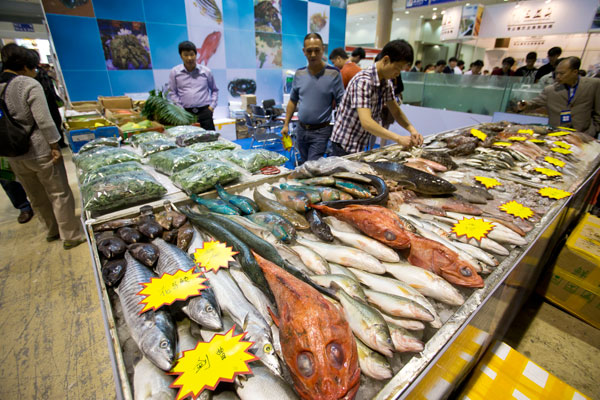Seafood businesses flounder amid spending cut
Updated: 2013-06-14 02:10
By WANG ZHUOQIONG (China Daily)
|
||||||||
|
 |
|
Seafood products displayed at a food and catering fair in Beijing. The crackdown on graft and extravagance is taking its toll on the country's high-end seafood market. PROVIDED TO CHINA Daily |
Piles of high-end seafood — including lobsters, crabs and abalone — sat quietly in the small tanks of various vendors, during a visit to one of the largest aquatics markets in northern Beijing this week.
Store owners at the market, a major wholesaler for restaurants in the area, said they were disappointed by the sluggish levels of business for expensive aquatic products in recent months, the result of the ongoing decline in luxury catering across the nation.
"Top restaurants have cut their demands for high-end products," said one shop owner surnamed Lin.
"Expensive seafood such as abalone and lobsters are difficult to sell, despite prices dropping 30 percent compared with last year."
A kilogram of abalone now costs around 80 yuan ($12), against 140 yuan a year ago, and a lobster can be bought for less than 100 yuan, according to Li Jianchao, a restaurant owner in Beijing.
Abalone and lobster account for the majority of high-end seafood dishes in luxury restaurants.
Sales of imported dried seafood being sold in Jingshen Seafood Market in southern Beijing, for instance, have dropped two-thirds with almost zero demand from high-end restaurants, according to a report in China Securities Journal.
In such a depressed market, many high-end seafood traders have been forced to quit the businesses altogether, the journal added.
High-end seafood products at lower prices have lured many individual customers, however, while some medium and lower priced seafood remains popular, with some prices even rising, said Lin.
Bian Jiang, assistant director of the China Cuisine Association, said a decline in retail and wholesale seafood sales is inevitable, as the catering industry slows, and the effects are also hitting other related sectors of the industry, from breeding, to feeding, fishing, and seafood imports and exports.
"It has been the worst time for seafood-related industries in a decade," Bian said.

 Michelle lays roses at site along Berlin Wall
Michelle lays roses at site along Berlin Wall
 Historic space lecture in Tiangong-1 commences
Historic space lecture in Tiangong-1 commences
 'Sopranos' Star James Gandolfini dead at 51
'Sopranos' Star James Gandolfini dead at 51
 UN: Number of refugees hits 18-year high
UN: Number of refugees hits 18-year high
 Slide: Jet exercises from aircraft carrier
Slide: Jet exercises from aircraft carrier
 Talks establish fishery hotline
Talks establish fishery hotline
 Foreign buyers eye Chinese drones
Foreign buyers eye Chinese drones
 UN chief hails China's peacekeepers
UN chief hails China's peacekeepers
Most Viewed
Editor's Picks

|

|

|

|

|

|
Today's Top News
Shenzhou X astronaut gives lecture today
US told to reassess duties on Chinese paper
Chinese seek greater share of satellite market
Russia rejects Obama's nuke cut proposal
US immigration bill sees Senate breakthrough
Brazilian cities revoke fare hikes
Moody's warns on China's local govt debt
Air quality in major cities drops in May
US Weekly

|

|








